This post was inspired by Eli J. Finkel's 2017 eye-opening book "The All-or-Nothing Marriage: How the Best Marriages Work."
In it, he describes the progression from pre-industrial "tribal" marriages in which multigenerational families worked together on their farms and small businesses to survivie and be safe (which I experienced in the small village where my mother grew up), through a brief period of industrial-age marriages with a focus on belonging and love in which men went to work and women were predominantly homemakers (which I experienced with my parents), to most of today's marriages and partnerships in which educated women who earn their own income not only seek attractive men with higher levels of education and income to "marry up to," but who also fulfill their "esteem," and "self-actualization" needs that Finkel shows in his "Mount Maslow" hierarchy of needs below.
Finkle's book is largely based on research with the latter group, which makes up about 30% of the population, and what makes their marriages (including his own) work, including "love hacks" like lowering expectations, touching your partner, not jumping to conclusions, visualizing an argument from the outside, making a gratitude list, accepting compliments, celebrating small victories, watching porn, and masturbating, as well as deeper work like couples therapy, improving communication (which only works between couples at the same level of consciousness development), and consensual non-monogamy to spice up their sex lives. Unfortunately, he has no advice for the remaining 70%.
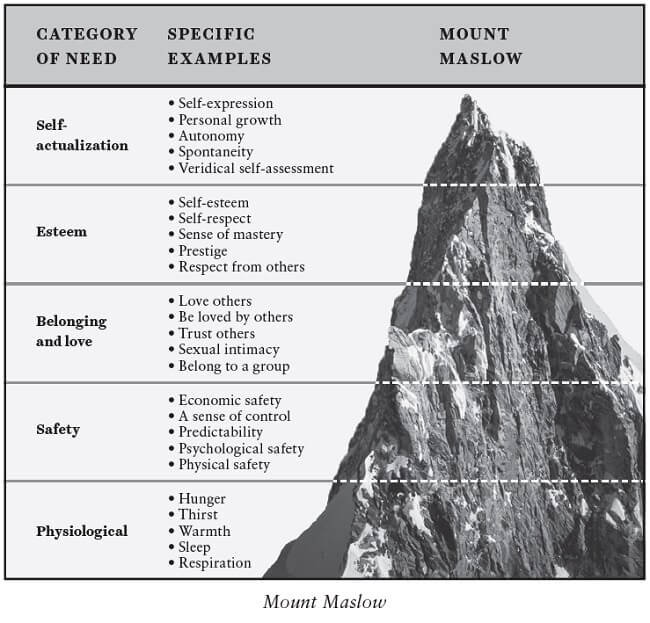
Image above: Finkel's Mount Maslow
The challenge with these new "all or nothing" relationship and marriage expectations, especially for women, is that about 75% of men occupy the bottom of the personal growth pyramid, while the middle has about 75% women, and the small top (maybe 1 in 10,000) has about 75% men, as evidenced by The Watkins List of 72 men and 28 women, and many women citing men as their primary teachers and inspirations, whose groups, workshops and trainings they attend, and whose books they read.
In other words, there are three times more potential partners for every woman at the bottom, three times more potential partners for every man in the middle, and three times more potential partners for woman at the top.
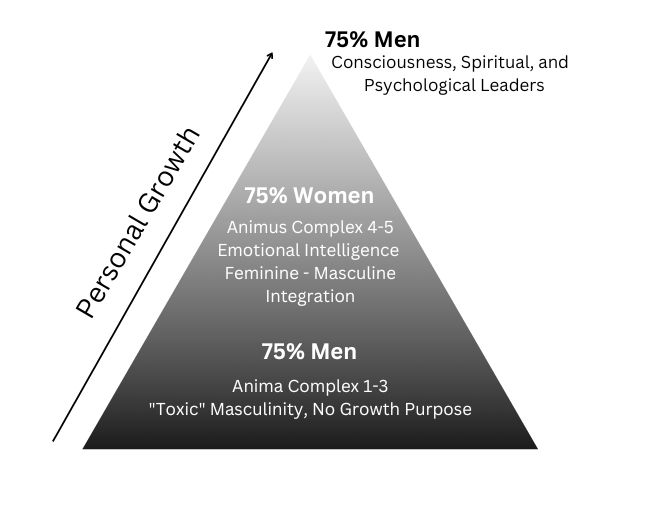
Image above: Women-Men Growth Pyramid
This mismatch in personal growth and healing, with many women in the middle of the pyramid being stuck in stage 4 of their Animus Complex development and avoiding committed relationships, and men in the bottom of the pyramid in stages 1-3 of their Anima Complex development seeking "mothers," "sex objects," or "traditional wives," leads to increasing numbers of singles around the world as shown below, and deprives them of learning, growing, awakening, and healing their relationship wounds in relationships.
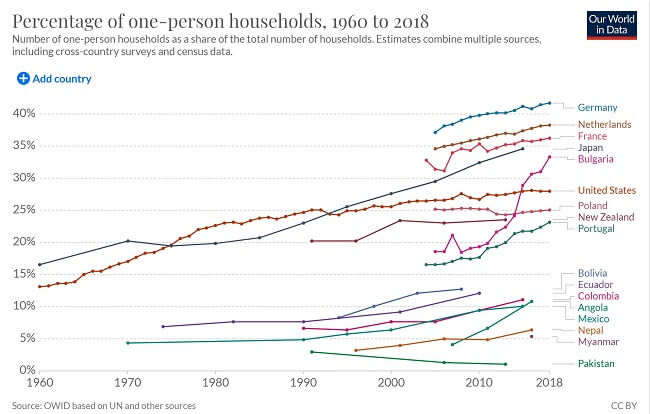
Image above: Our world in Data one-person households.
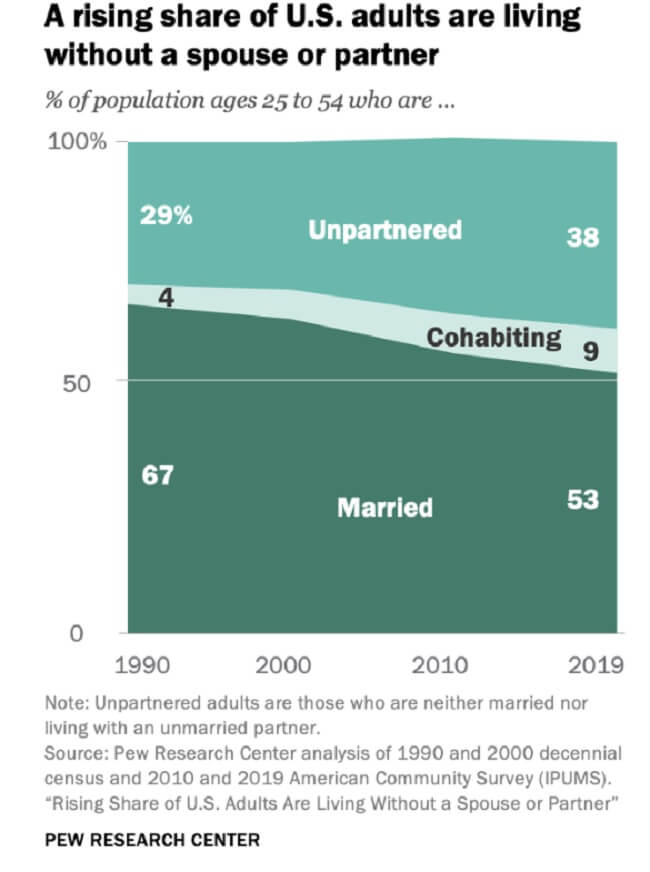
Image above: PEW Research about rising share of U.S. adults who live alone
The rise of singles is especially affecting men around the world who can't live up to women's expectations and are living alone or with their parents.
See, for example, NYU Professor Scott Galloway on CNN and the book Of Boys and Men.
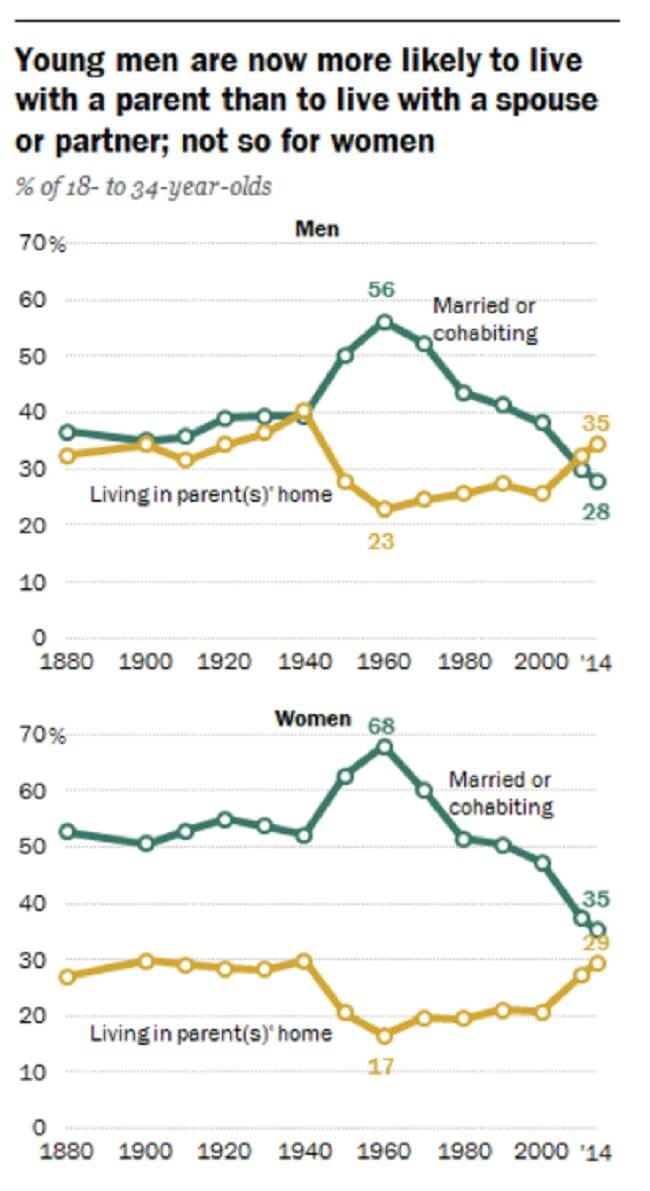
Image above: PEW Resarch young men more likely than women to live alone (or with parents) (a.k.a. failure to launch)
These single-person households are also a major contributor to the housing crisis and global warming because they don't share resources.
As we can see in the chart below, people across the income spectrum have similar desires in kind, e.g. wanting husbands who have steady jobs and higher incomes, understand (and support) each other's hopes and dreams, spend (quality) time together, (men equally sharing houswork and childcare), and communicate effectively, but men are finding it increasingly difficult to meet these desires to any degree.

Image above: From all or Nothing Marriage
This understandable "all or nothing" approach to relationships by women makes it harder for men to find partners. Only 38% of single women vs. 61% of men (29% vs. 55% over 40) are looking for a partner, 75% of TINDER users identify as male, Bumble's male/female user distribution is 67.4% male vs. 32.6% female, and 56% of women vs. 35% of men say they have a hard time finding someone who meets their expectations, as I've written here and as shown below.
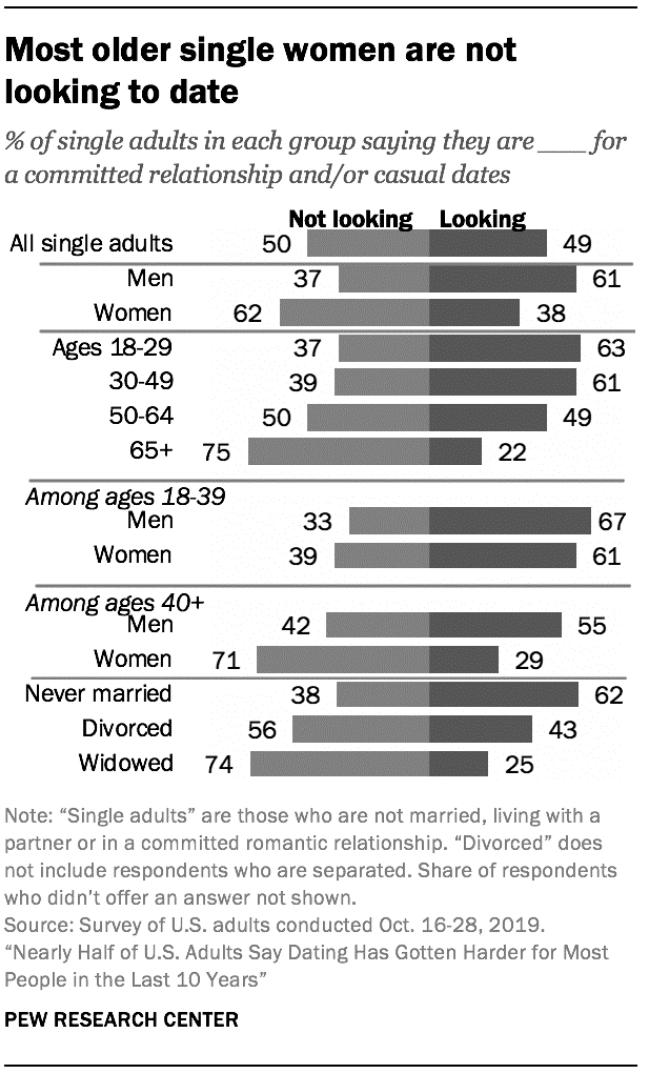
Image above: Most single women are not looking to date
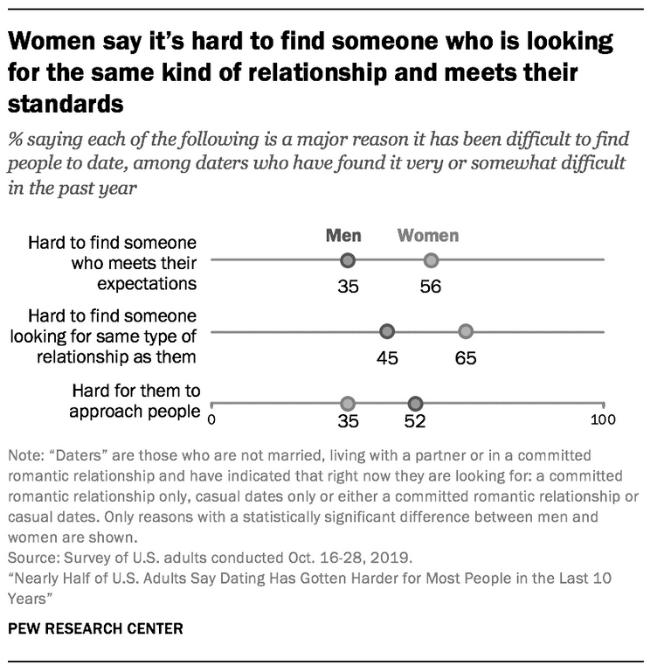
Image above: 56% of women saying that it is hard for them to find someone who meets their expectations
We also see this struggle of men with lower incomes and education in the stark differences in marriage and divorce rates between less and more educated couples, since many low-income women are rather poor on their own than poor in a bad relationship.
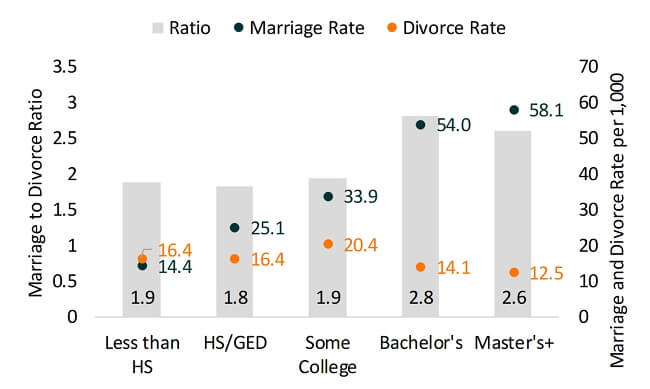
Image above: People at higher levels of education and income have the highest marriage rates and lowest divorce rates
In general, 70% of divorces are initiated by women. According to The Whitley Law Firm, that number jumps to 90% among college-educated women. They cite three main reasons why women leave their husbands:
1 – Women are more likely to feel held back by the marriage.
2 – Women often take on more of the emotional burden.
3 – Women no longer (have to) tolerate consistent unacceptable behavior.
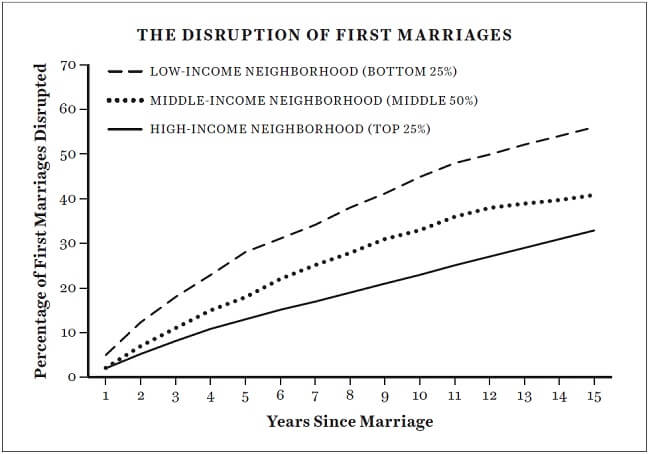
Image above: Divorce Rates by Income
One of the reasons for the education and income gap in divorce rates is that women traditionally married up. To meet their needs for survival, safety, love, and belonging, most unemployed women married laborers, nurses married doctors, secretaries married managers, typists married lawyers, etc.
Today, as more women around the world graduate from college than men, professional women are choosing husbands more laterally; doctors marry doctors, lawyers marry lawyers, etc. and thus further shrinking the middle class. These couples have more resources to hire mates, nannies, babysitters, gardeners, and other professional services, so they have less stress and more time to focus on their relationship and pay for marriage counseling.
These lateral marriages prevent less educated women from marrying up, force them to work full time to make ends meet, and to choose from a shrinking pool of men who are equal to or even below them in education, income, and maturity if they want to be in a relationship. These couples obviously don't have the resources and time of higher educated/earning couples to make their relationships work, leading to higher divorce rates.
With up to 25% more women than men in higher education worldwide, this trend will only continue.
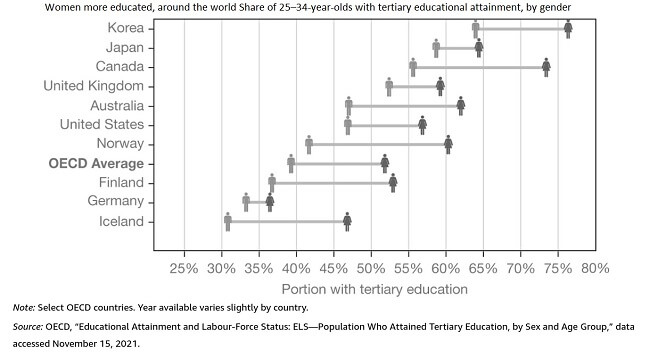
Image above: Women are more educated around the world
Somewhat paradoxically, households with the lowest incomes still have the highest number of births, further feeding the bottom of the educational and income pyramid (see Dream Hoarders: How the American Upper Middle Class Is Leaving Everyone Else in the Dust, Why That Is a Problem, and What to Do About It by Richard Reeves).
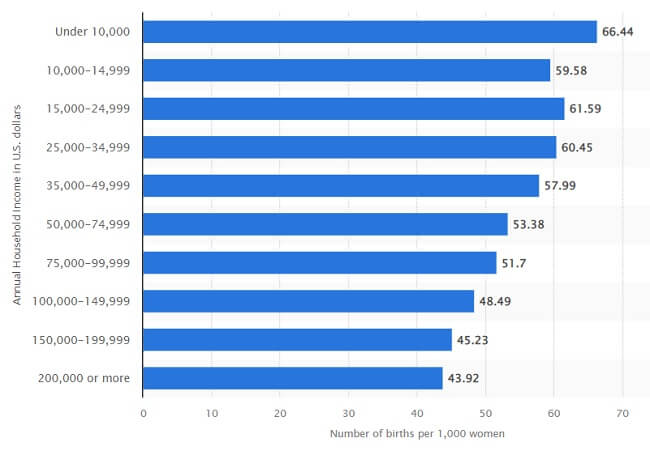
Image above: Households with the lowest incomes have the highest number of births
In other words, the traditional pyramid, with a majority of men at higher levels of education and income, and women marrying up to them, as my parents did, is increasingly being reversed, and men are falling behind. In some countries (most extreme in Afghanistan and Iran, but also in emerging "illiberal democracies" that often promote traditional patriarchal and religious values), men are trying to maintain or restore the old world order by oppressing women. Time will tell to what extend they succeed.
For me, the only meaningful solution to humanity's challenges is NOT to reduce support for girls and women, or to blame or oppress them, but to also support men in their educational and economic development, as suggested by Prof. Galloway and advocated by Richard Reeves in his 2022 book "Of Boys and Men" (see my blog post here). In addition, we also need to support them in their personal growth and development and living on purpose, as suggested in the Integral Relationship Model.
This requires systemic change AND that men get in touch with and heal their shame-based identifications that are covered up by the pride-based counter-identifications (as supported by NARM and similar healing methods) that often manifest as (what is now called) "toxic" masculinity. This allows them to open up to healing their unconscious complex developmental trauma that often keeps them from meeting women on their level and contributing to a better world.
Click here to read more why relationships matter.

test